These days, Nissan is struggling for survival. Last year, it tried to merge with Honda, but the deal fell apart when Honda saw it more as a takeover than a merger. The company hasn’t really been seen as much of a leader in the industry for many years. But 15 years ago, many perceived it as a leader in the field of electric vehicles. While Tesla had launched the first long-range EV with a lithium ion battery in the form of the first Roadster, Nissan brought out the first relatively affordable modern EV in the shape of the original Leaf. Then-CEO Carlos Ghosn announced big plans to introduce many more EVs in the 2010s, but those plans largely stalled and Nissan has floundered. Fifteen years after the debut of the original Leaf, Nissan is trying to reboot with an all-new generation and we’ve had a chance to drive it. Will this be the car that kick-starts Nissan?
The original Leaf was a compact hatchback at a time when that form factor was still selling reasonably well. Unfortunately it had several challenges.
First off, it was a bit peculiar looking — something like an alien insect. In its original form, it also had a pretty short range. At the same time that the original Tesla Roadster had more than 200 miles of range, the Leaf came to market with just 73 miles.
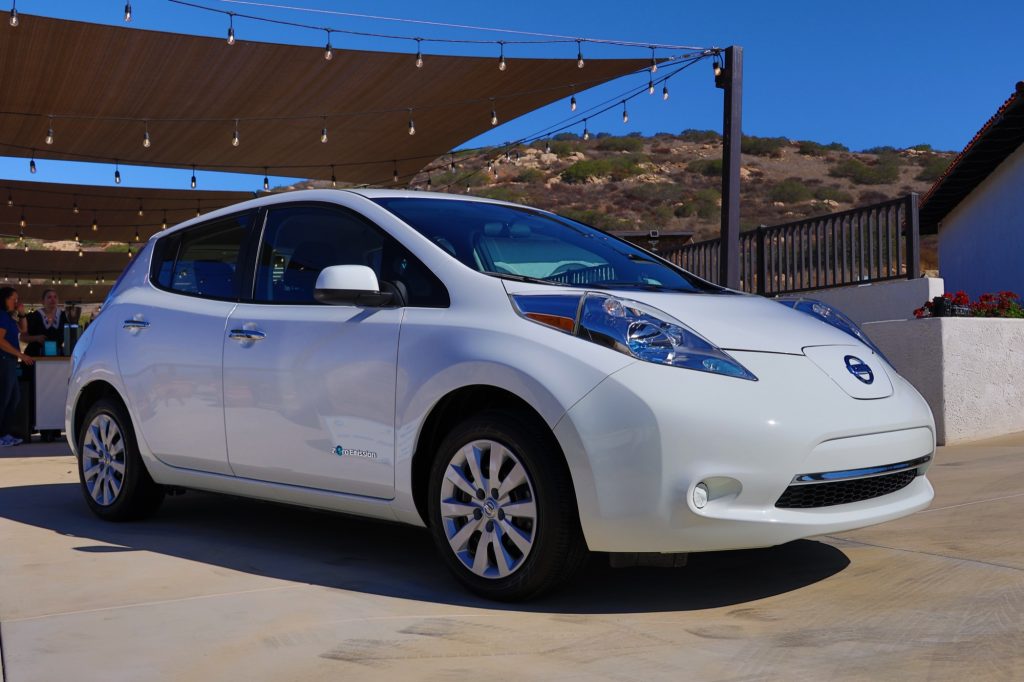
But perhaps the biggest issue with the early Leaf was the decision to use an air-cooled battery pack. Most of the early US sales of the Leaf took place in warm weather regions like California and Arizona. Unfortunately, the inadequate thermal management system meant that owners using the car in very hot weather like Phoenix in August started seeing some pretty significant premature degradation of the battery. That’s why it’s probably wise to avoid buying a used early Leaf as David Tracy found out. Over time, Nissan did improve the batteries and the thermal management although the battery remained air-cooled all the way until this year.
It wasn’t all bad for the old Leaf. It was reasonably roomy and was the first EV to include DC fast charging. Since it launched before the CCS or Tesla NACS standards were developed, it used what was available, the Japanese CHAdeMO connector. Max charging speeds were limited to 50-kW but that was fine given the cooling challenges and the mere 24-kWh capacity of the first iteration.
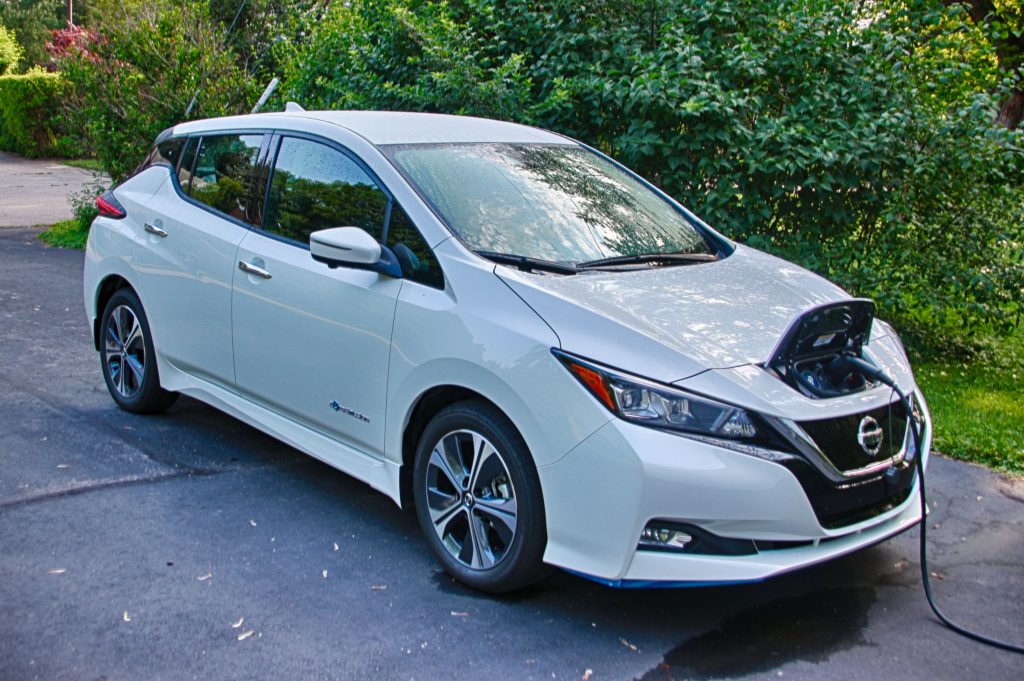
In 2017, a second-generation arrived that retained the original platform but got an all-new skin that looked more conventional. The battery grew to 40-kWh with the range getting bumped to 150-miles and eventually a plus model with a 60-kWh battery and 220 mile range joined the lineup.
A Complete Reboot
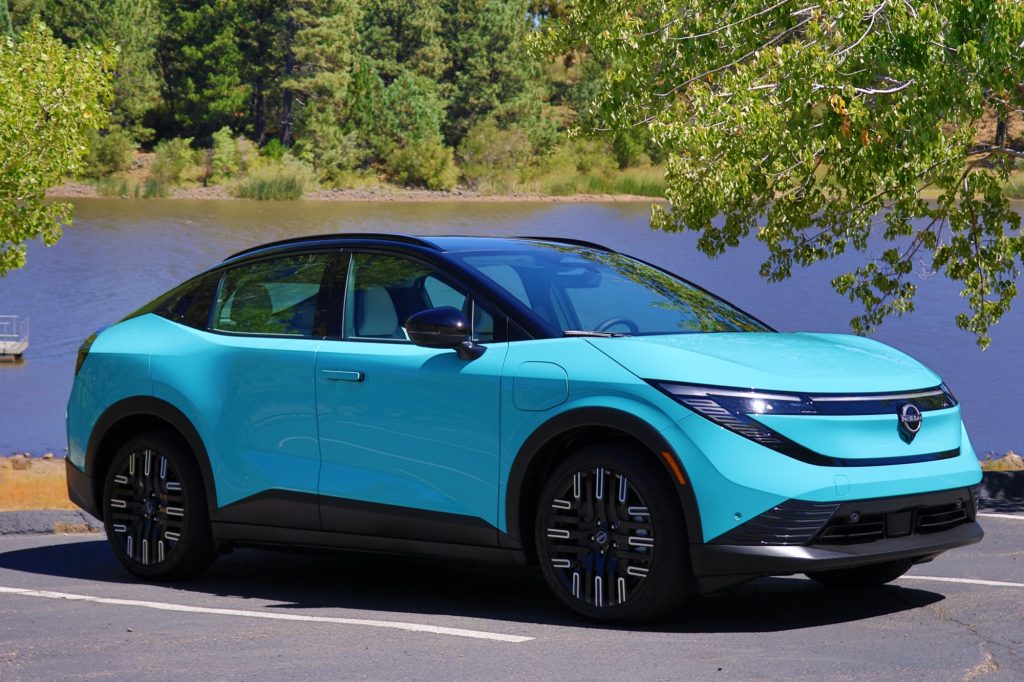
For 2026, the Leaf gets a complete reboot that finally abandons almost everything from the original. Interestingly, Nissan has actually made it smaller than before, something that is almost unheard of in this industry. It’s about 3-inches shorter and 0.8-inches narrower with 0.4-inches less wheelbase.
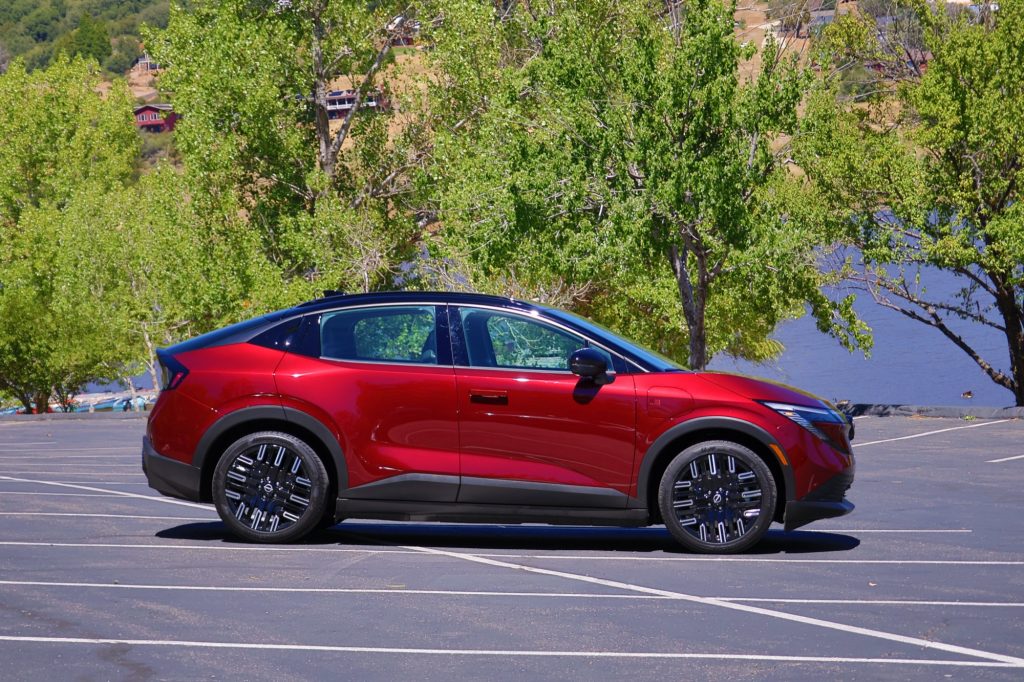
What may be most crucial to the potential success of this new Leaf though is the shape which most would now describe as a crossover coupe.
Let’s be completely clear, there is nothing about this car that is an SUV apart from that profile. This of course is no different from the vast majority of vehicles that are marketed as SUVs or crossovers. I personally don’t like that we have to call something an SUV just to get potential buyers to even consider it now even when it is very clearly a car, but such is the nature of consumer perceptions in the 2020s. Nonetheless, I’m going to call this a compact hatchback.
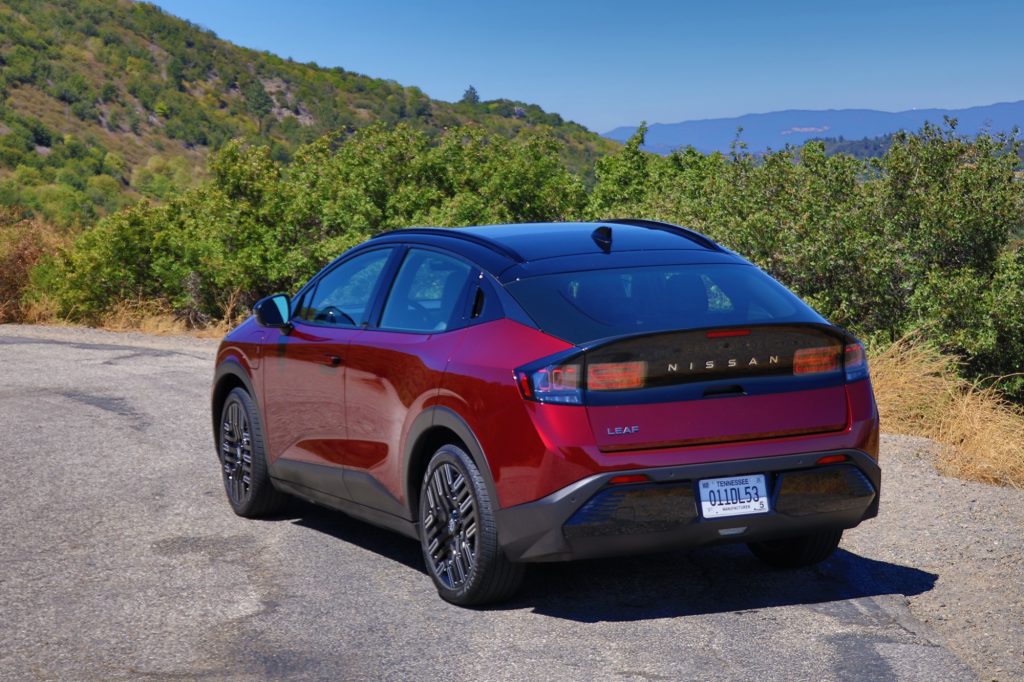
I first saw the new Leaf two years ago when we visited the Nissan design center following the Japan Mobility Show. Nissan’s design chief Alfonso Albaisa gave us a tour of more than two dozen vehicles, essentially everything the company was working on for the next several years. Many of those vehicles have since launched including the new Armada and QX80, the Murano and the cool little Micra that Americans won’t get because we can’t have nice things. Other stuff I still can’t talk about while others may or may not actually make it to production due to the shifting market dynamics for EVs and Nissan’s financial health. That would be a real shame because there was some really interesting product that was destined for America.
When I laid eyes on the new Leaf, my first thought was that it’s a ⅞ scale Ariya which is not at all a bad thing. It definitely has a strong family resemblance to the midsize EV but with some interesting details that set it apart. Starting at the front, one element we’ve seen on recent models like the Kicks and Murano is the stacked horizontal light bars as a signature in the corners. On the Leaf this is executed as hollow rather than solid rectangles.
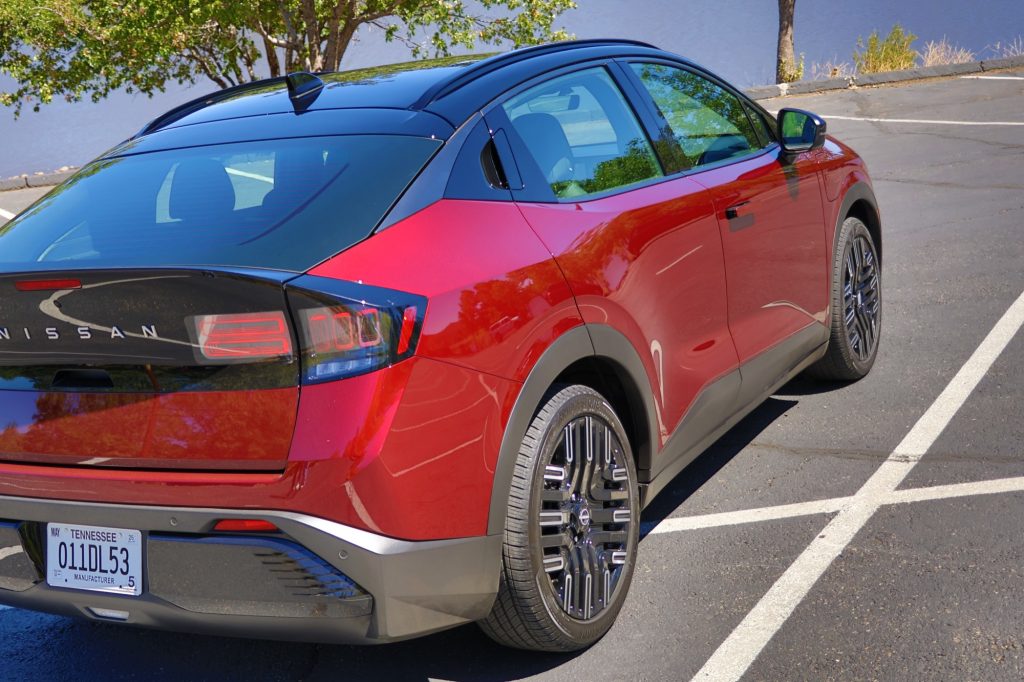
Along the sides, the more conventional door handles of the Ariya are replaced with somewhat hidden units. Pop-out handles are used on the front doors and sit flush for reduced drag when the Leaf is in motion. The rear door handles are hidden in the C-pillar.
Around the back, we see the new signature flourish of the Leaf in the taillamps which consist of three vertical bars and two horizontal. These bars represent the Japanese digits for two and three which in the language are pronounced as ni and san. It’s a clever little easter egg if you look at the right rear corner. If you’re reading Japanese which goes right to left, then you’ll want to focus on the left rear corner which is the mirror image.
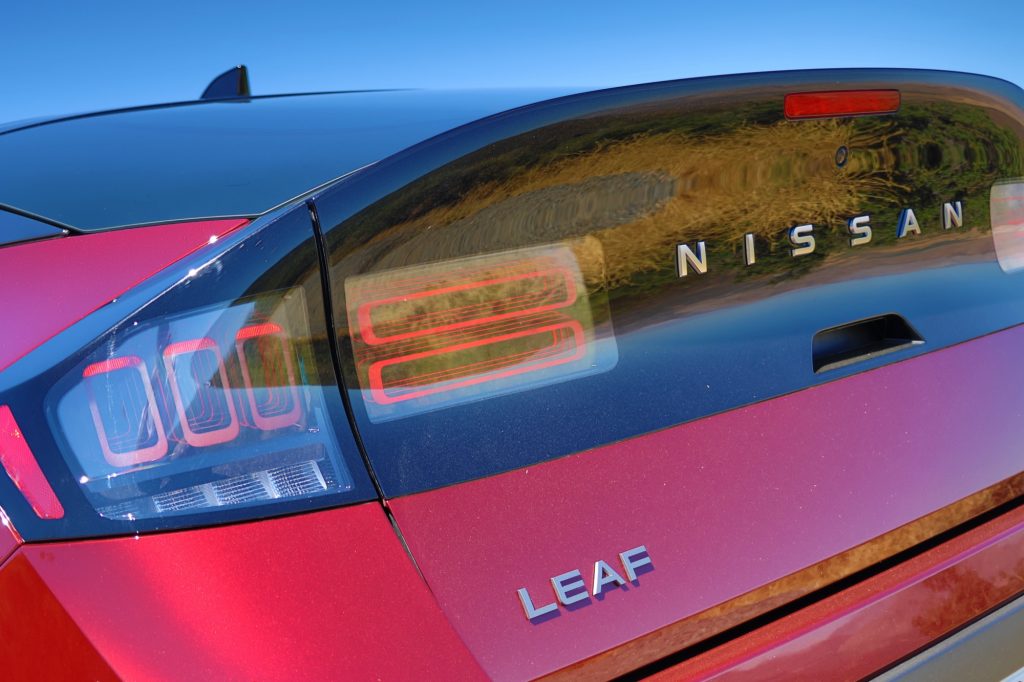
According to Nissan, that same iconography shows up in 16 places on the car – we spotted eight – on the door sills, the charge port doors and next to the outboard dash vents in addition to the taillamps. The two horizontal bars also provide a bit of connection to the Z32 300ZX and the current RZ34 Z. I particularly like how these lights have been executed to appear as layers that provide the appearance of depth to the lights.
There is one other important exterior detail, the two charging ports on each front fender. The first two Leaf generations always had the charge ports under a flap above the front bumper. There was an SAE J1772 port for AC charging and the CHAdeMO port for DC charging side by side. The Ariya for North America dropped CHAdeMO in favor of a CCS port on the right front fender.
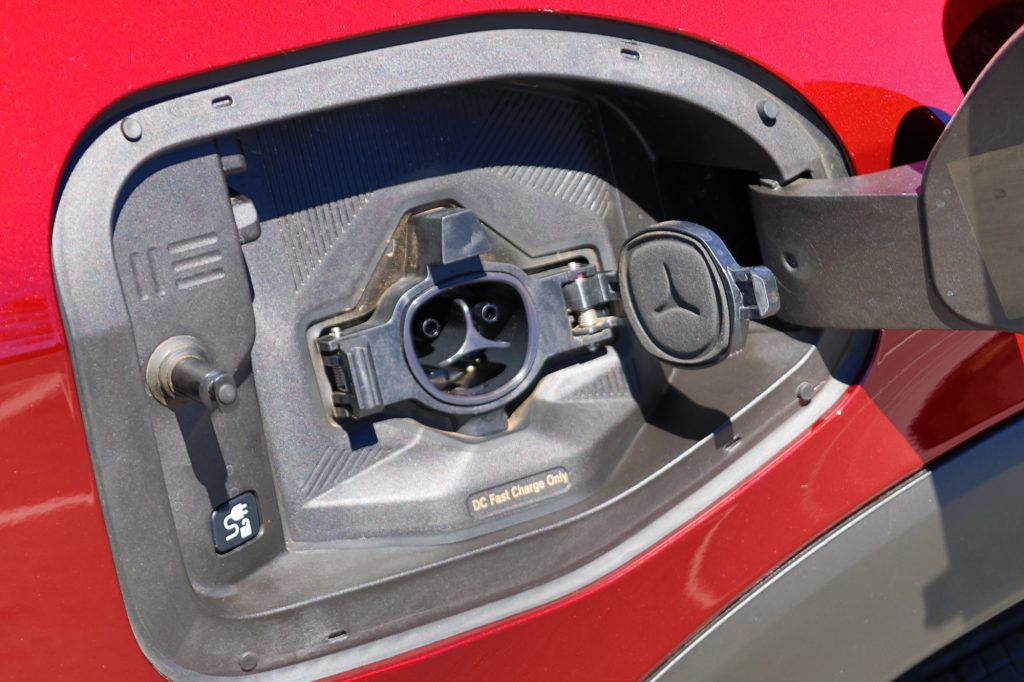
On the Leaf, there is a J1772 port on the left front fender for AC charging at home and a J3400/NACS port on the right front. Nissan explains that they retained the J1772 on the left because it’s close to where the driver gets out and they can easily plug in when they get home. The NACS port on the right will be more convenient for drivers if they choose to use a Tesla Supercharger because the V3 dispensers have short cables that will reach this position. The NACS port only supports DC charging for now because the decision to switch ports came late in the development process and there wasn’t enough time to redesign the whole wiring circuit to also support AC through that port. That is promised for a future update to the Leaf.
In the Cabin
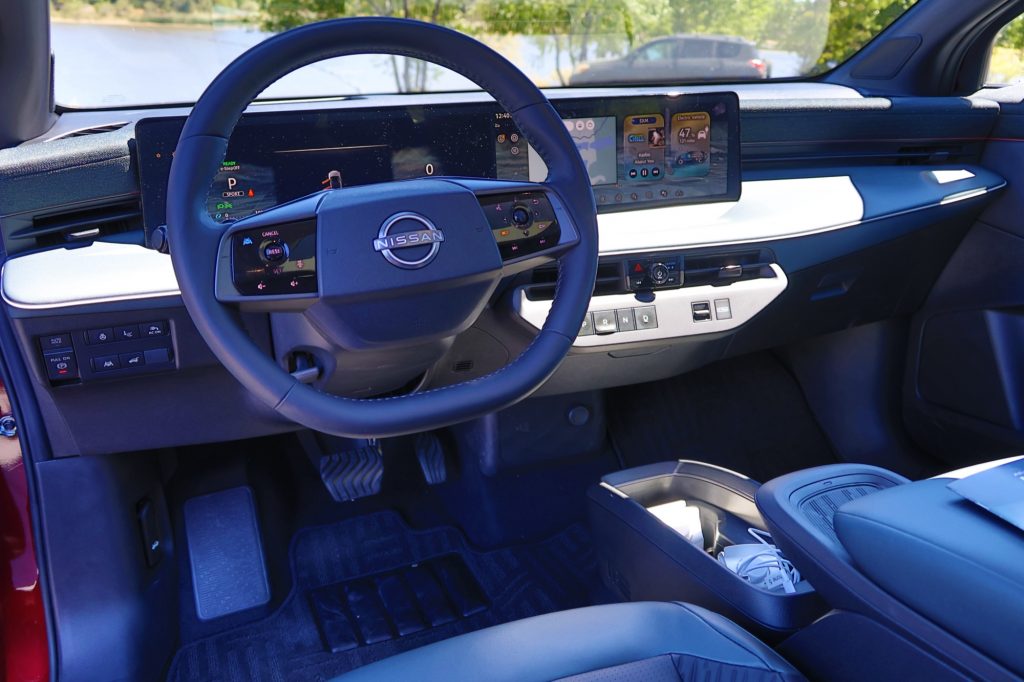
The Ariya resemblance carries over to the interior of the Leaf. The design is clean and uncluttered. The peculiar gear selector of the old Leaf has been discarded in favor of the push button layout that Nissan has been favoring in recent years. While I appreciate physical controls over touch controls in a car, I’d prefer a steering column stalk over the push buttons for this use case but I could live with the buttons.
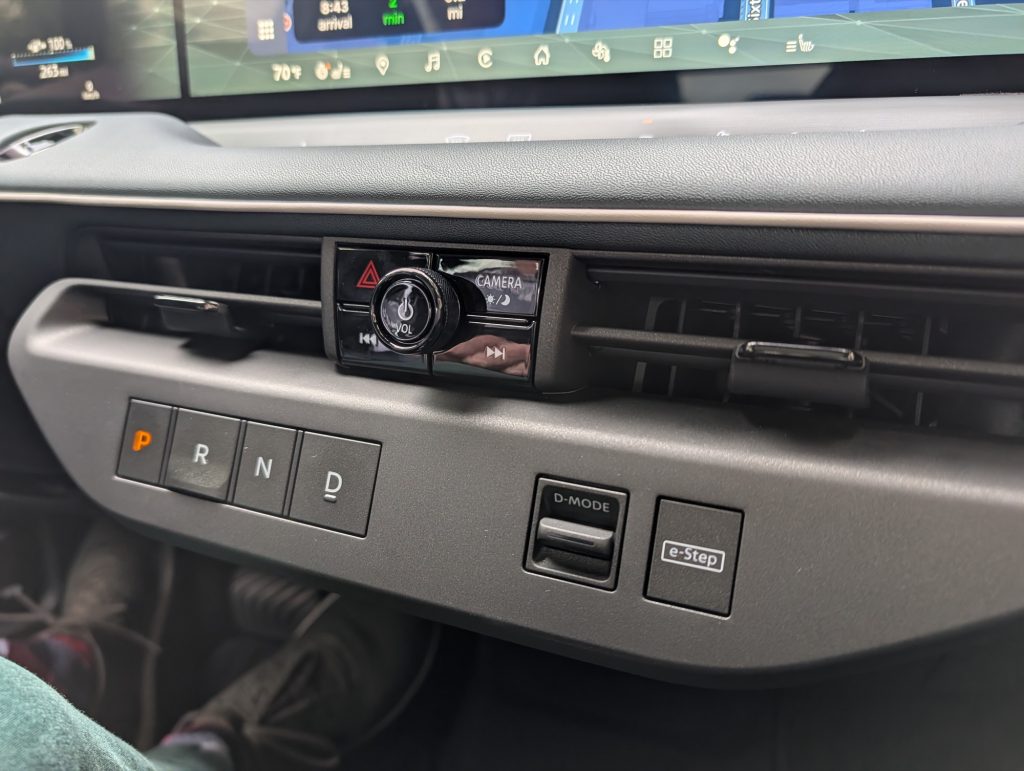
Like the Ariya, there is a large panel on top of the dash containing two displays, the instrument cluster in front of the driver and the infotainment touchscreen to the right. On the S and S+ trims, the displays are each 12.3-inches and the infotainment runs an updated version of Nissan’s software that has been in use for many years. It’s adequate, but most drivers will probably take advantage of the standard wireless Apple CarPlay or Android Auto capability.
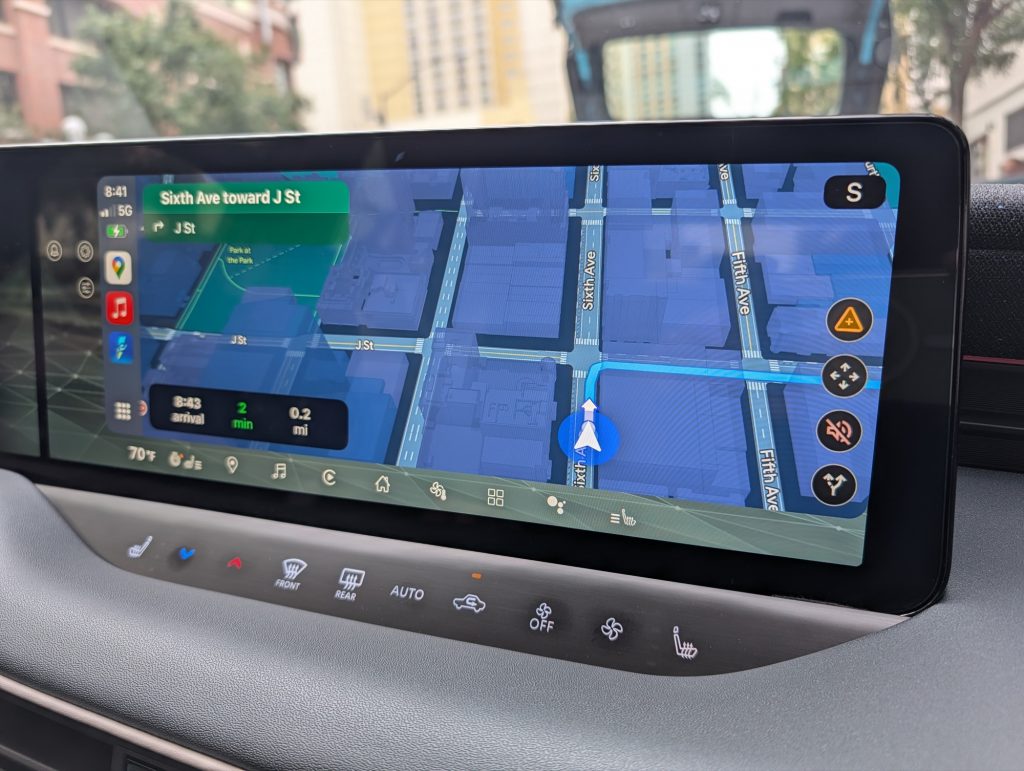
Stepping up to either the SV+ or Platinum+ trims provides larger 14.3-inch displays and Google built-in software that includes Maps, Assistant and the Play store. Google Maps is integrated with the vehicle and the state of charge to provide route planning that includes suggestions of where to stop for charging and estimated state of charge on arrival. Drivers can also download additional apps for media streaming and other functions. However, this system requires connectivity to function and unlike GM which includes eight years of data for the Google services, Nissan only provides 1 year. After that you’ll have to pay up for a data plan for your car or go back to smartphone projection.
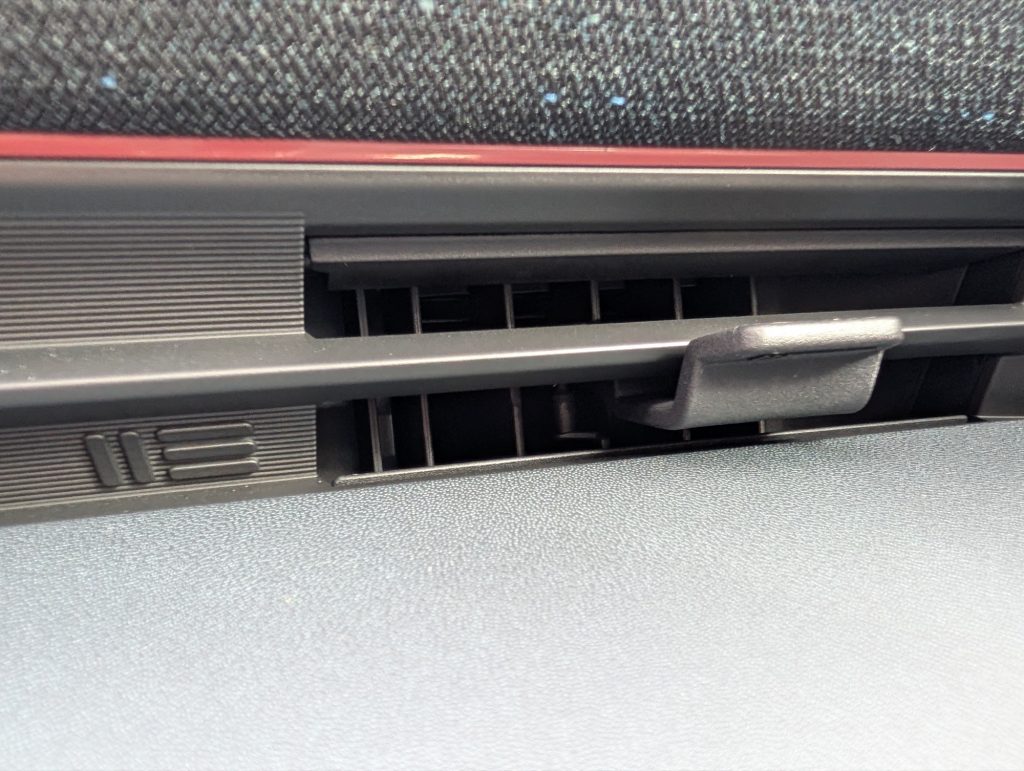
One thing we were happy not to see in the Leaf is an overabundance of piano black plastic. Over the years, we’ve criticized Nissan for apparently having purchased a long-term, high-volume supply contract for piano black plastic (see the interior of the new Armada) and this material inevitably ends up looking bad pretty quickly as the surface collects fingerprints and dust. The only signs of this in the Leaf are a quartet of small buttons for the camera view, hazard lamps and next/previous surrounding the central volume knob. The rest of the interior is matte finishes with nice textures that should hold up well. I particularly liked the fabric covering across the top of the door panels and dashboard that is present on all trim levels.
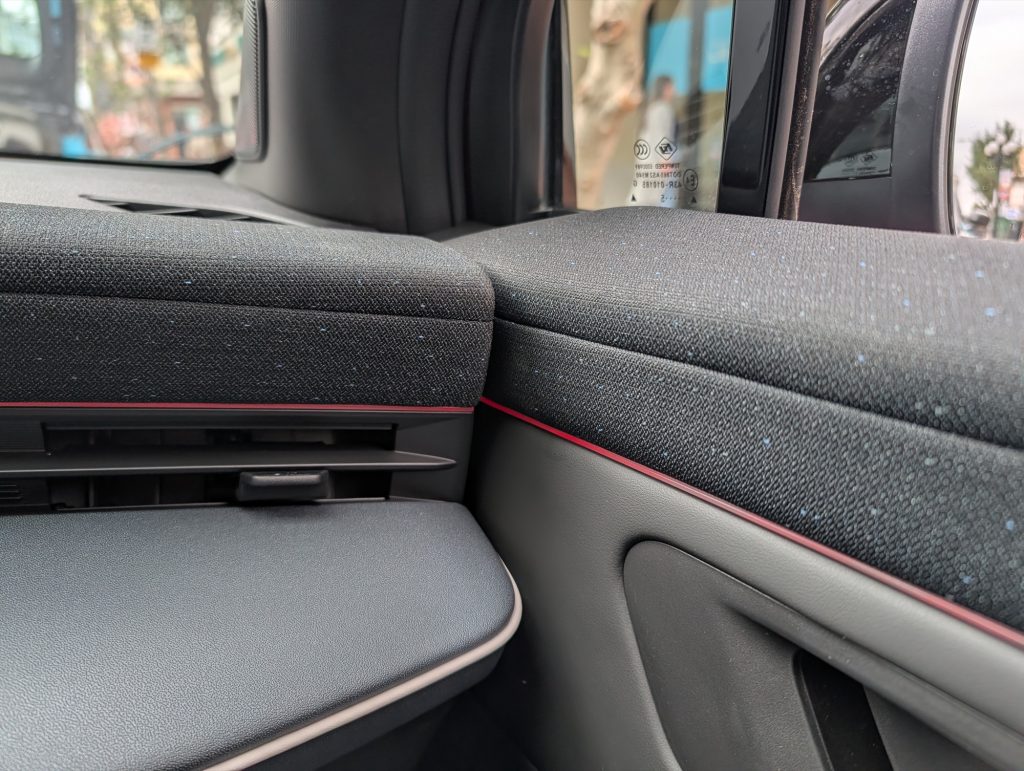
The entry trims get fabric covered seats while the two upper trims get a very nice synthetic leather and as usual, Nissan’s “zero-gravity” front seats were supportive and comfortable. Even after four hours in the car, I had no aches or cramps.
While I personally like the relatively modest footprint of the Leaf which should make it easy to maneuver around cities, it does take a toll on rear seat room. With the driver seat set for my 5-foot-10-inch frame, I can sit behind myself and have about an inch of knee room to spare. However, there is almost no toe room under the front seats which means the Leaf will be fine for transporting younger members of the family, but if you have teenage basketball phenoms, they might not be so happy in the back.
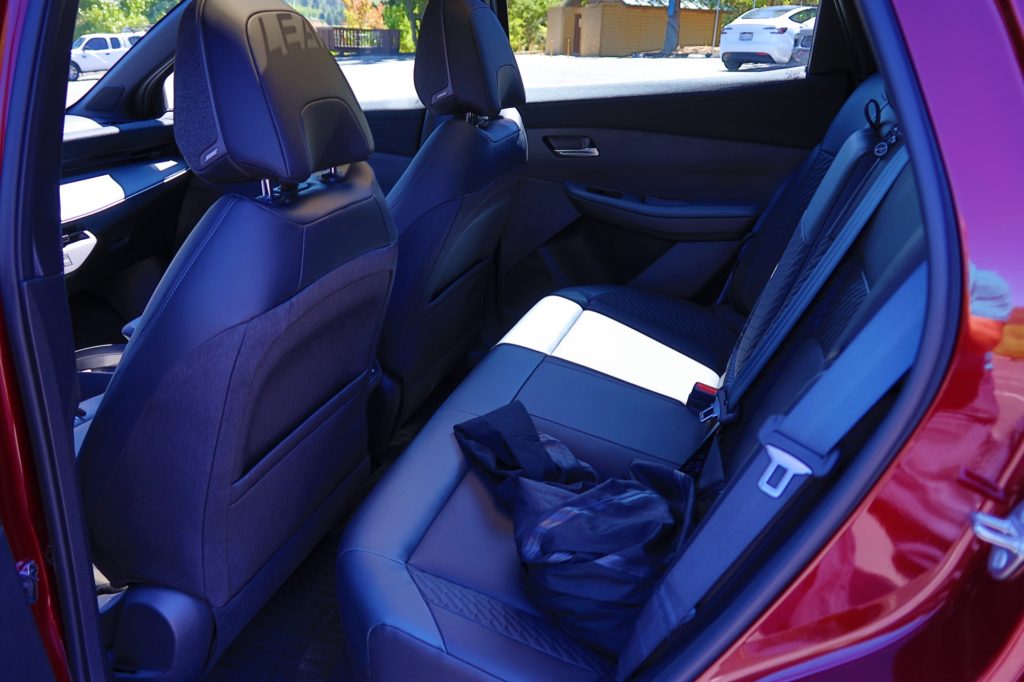
The Platinum+ also includes a glass roof panel with an electrochromic coating to transition from clear to translucent for some sun protection. Interestingly as you press the switch above the mirror, the roof goes opaque in sections as if you were sliding a traditional shade so front occupants can get full sun while those in the rear can get some shade if desired. The top trim also includes a heads-up-display.

Behind the rear seat you’ll find 20 cubic feet of cargo space that grows to 55.5 with the seats folded. However, since this is a front-wheel drive vehicle with a front overhang that is eight inches shorter than the previous editions, there is no frunk. All of the area under the hood is consumed by the powertrain and HVAC systems.
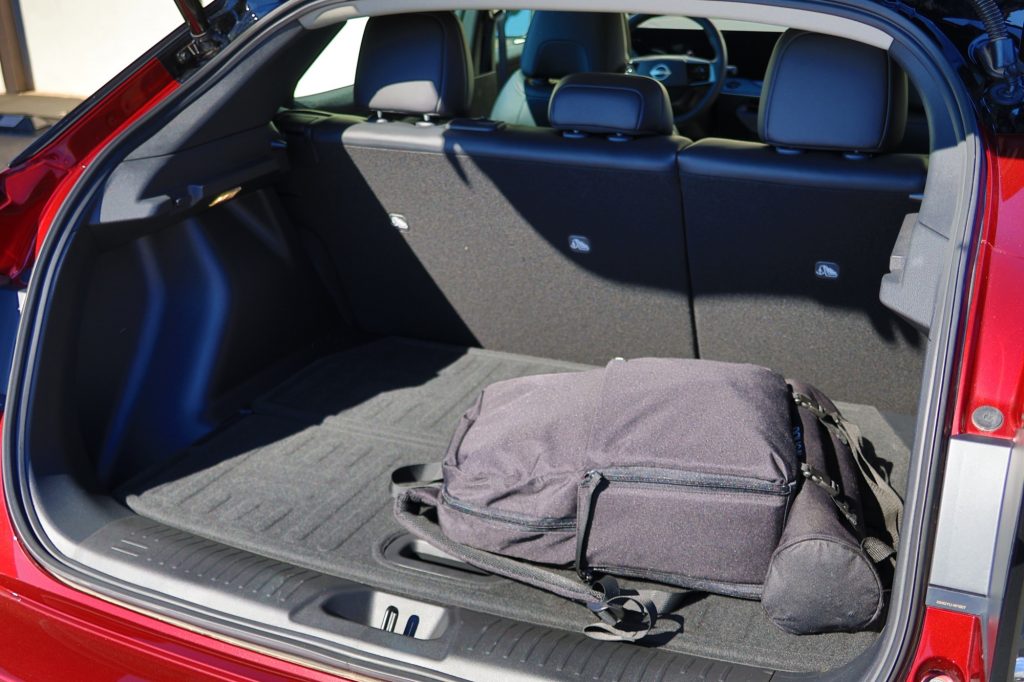
Speaking of climate control, it’s no surprise that some sacrifices had to be made to get the Leaf down to a $30K price point. In a world where dual zone climate control is pretty common even on a $22,000 Sentra, the Leaf only has a single temperature control for everyone in the car. Likewise ventilated seats aren’t offered even as an option on the Platinum+. Neither likely to be a deal killer, but they are details that had to be cut.
The Stuff You Don’t See

The new Leaf is built on the same Common Module Family (CMF) architecture as the Ariya and thus shares a lot of hardware with its larger sibling. The front suspension consists of MacPherson struts while the rear is supported on a four-link independent layout. Unlike the Ariya, there is no option for a rear motor to add all-wheel-drive to the Leaf. Nissan has also switched to a rack-mounted electric power steering actuator in place of the column-mounted used previously. This provides much more direct response and improved steering feel.
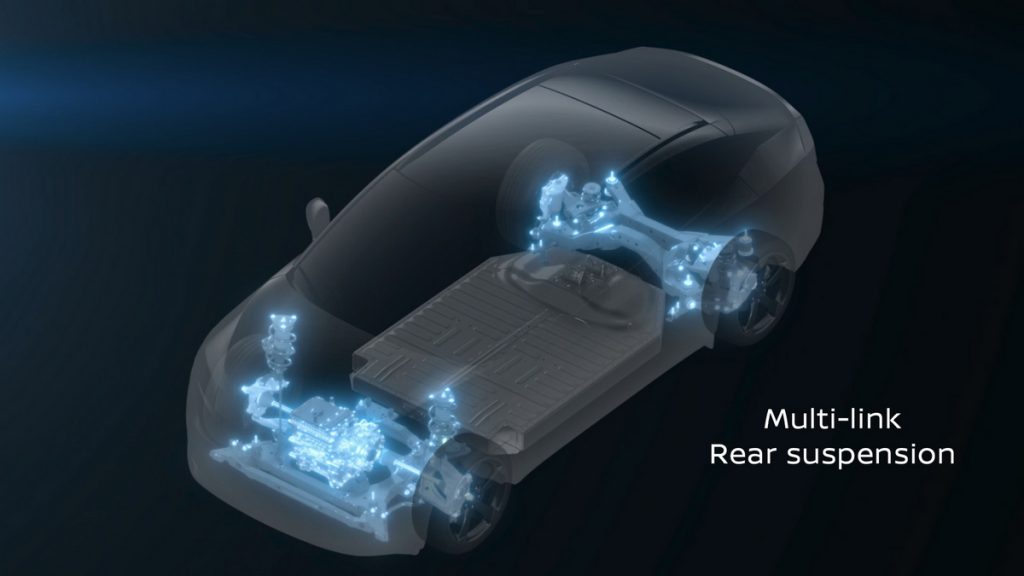
The Leaf is being offered with two wheel and tire sizes to start with. The base S and S+ get 18-inch steel wheels with full covers and 215/55R18 Yokohama all-season tires. The SV+ replaces the steel wheels with alloys of the same size. The Platinum+ steps up to 19-inch alloys with 235/45R19 Bridgestone Alenz tires. According to Christian Spencer, senior manager of vehicle evaluation and test, they provide the same performance specifications to all tire suppliers. Both combinations should provide comparable performance and all have the same suspension tuning so there is no functional advantage to going with the 19s, it’s simply a matter of appearance, but I’ll come back to that later.
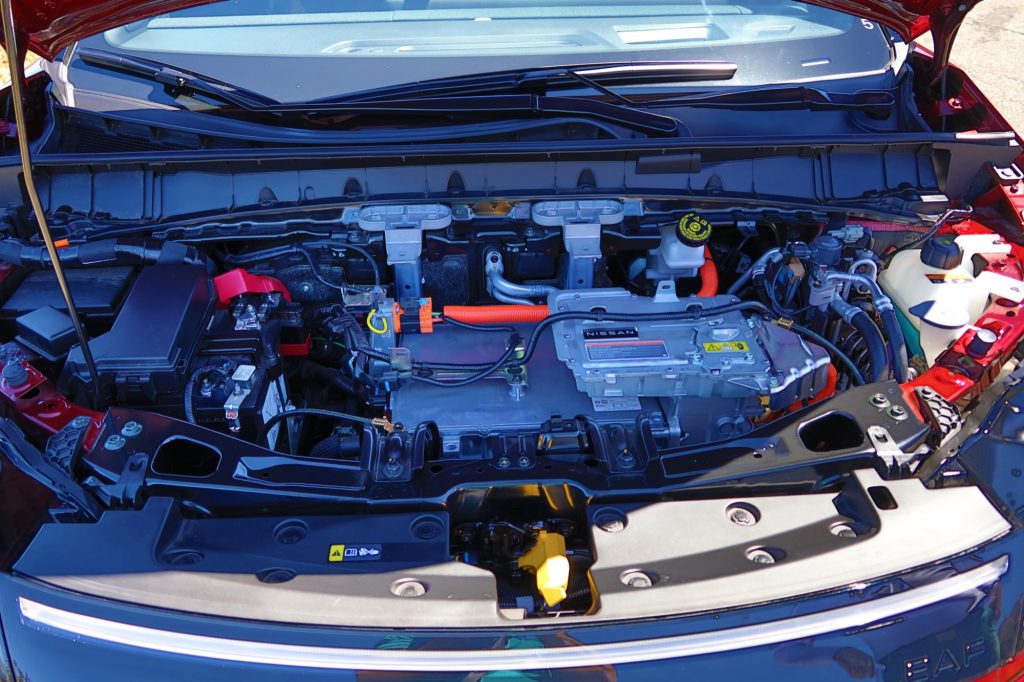
Speaking of the motor, the Leaf has a new 3-in-1 integrated drive unit that combines an oil-cooled, permanent magnet motor, the reduction gear set and the power electronics module in one housing. That makes it more compact than the old Leaf system, lighter, lower cost and cheaper to manufacture.
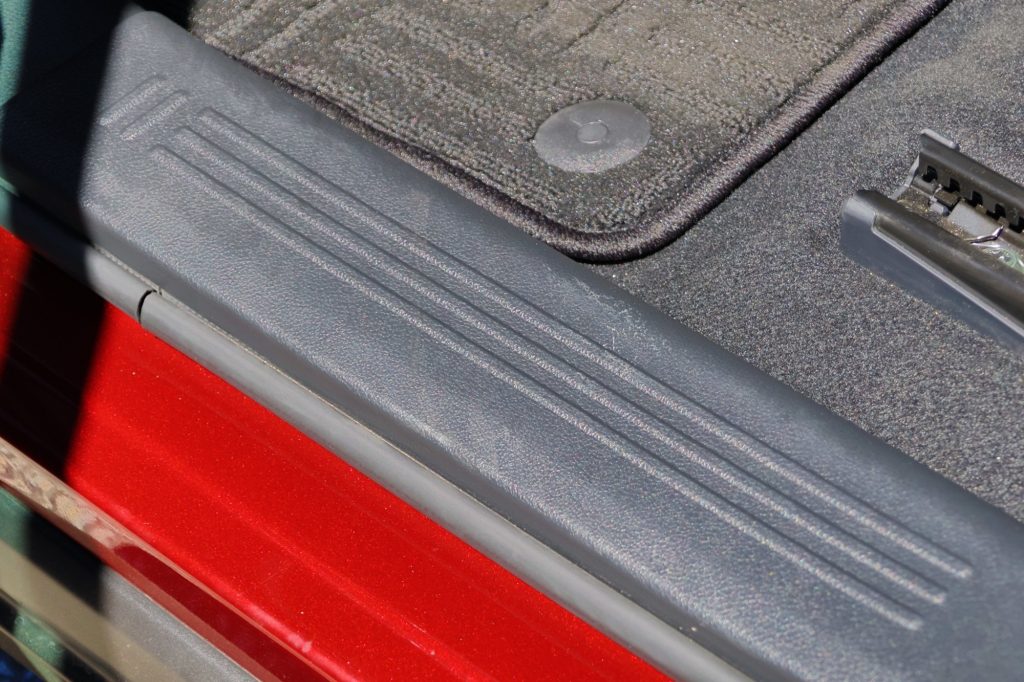
At launch, the Leaf is only available with a 75-kWh battery pack. A smaller 52-kWh version is coming in spring 2026 for the base S trim. With the larger pack, the drive unit produces the same 214-hp as the previous Leaf Plus but torque has increased from 250 lb-ft to 261 lb-ft. With the smaller pack, the drive unit will be limited to 174-hp and 254 lb-ft.
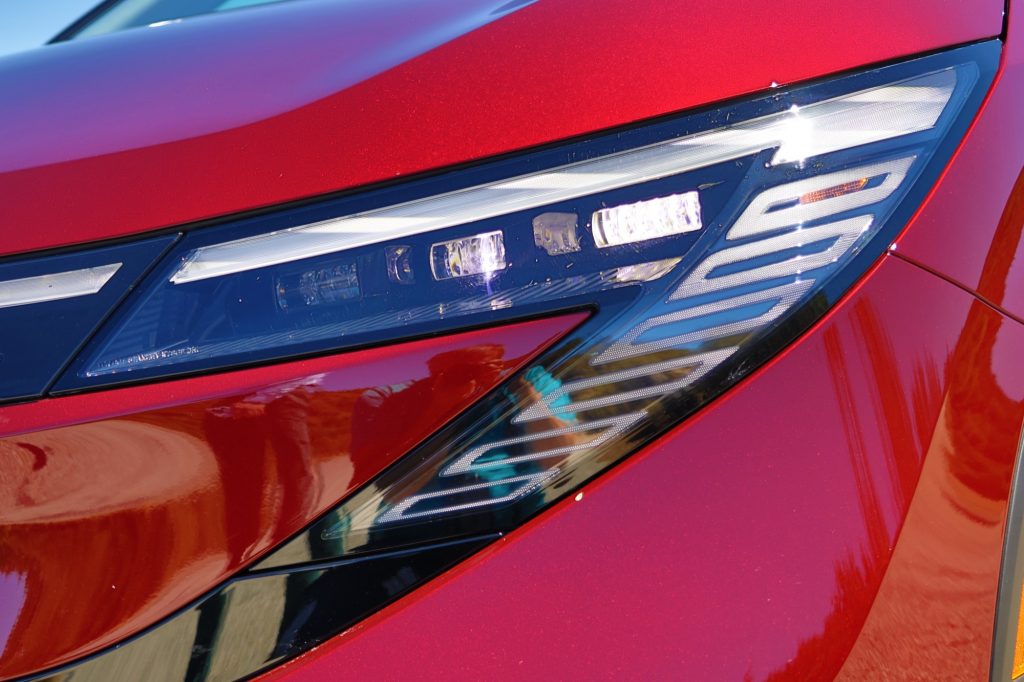
In addition to the new shape, probably the most important upgrade to the new Leaf is that battery. Back when the original Leaf was being developed in the late 2000s, cost was a critical element in trying to create a mainstream EV. Thus Nissan made the decision to go with an air-cooled battery pack while others adopted liquid cooling. Batteries, like humans, are quite sensitive to temperature and performance drops off significantly if it’s too hot or too cold. Unfortunately, when batteries get too hot, they can suffer permanent damage that degrades their energy storage capacity.
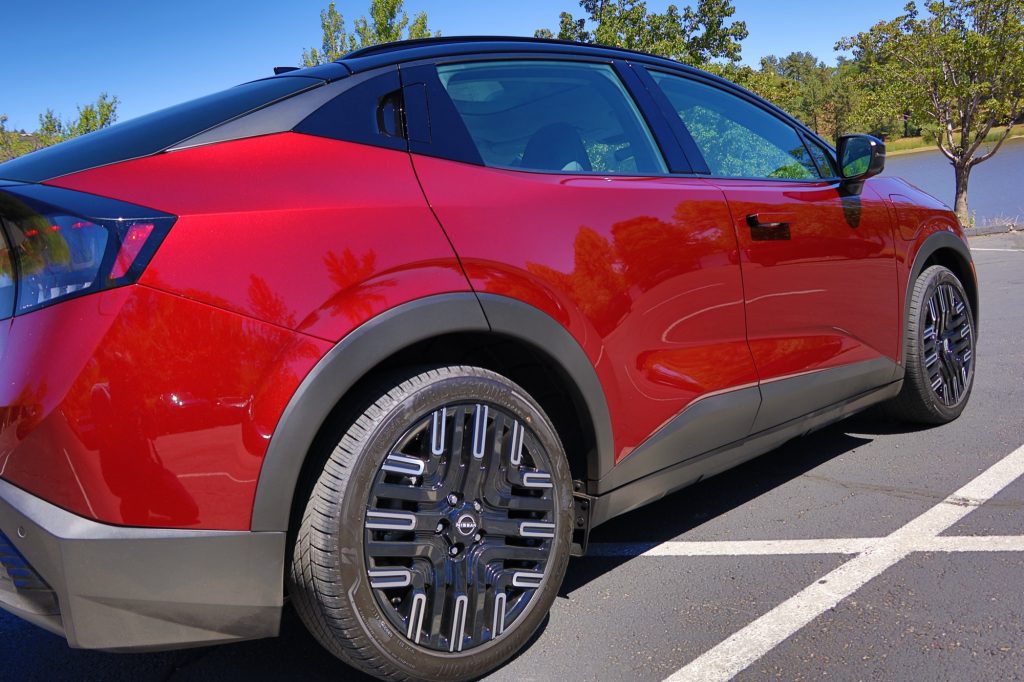
When the Leaf launched, it was initially only sold in the southwest including California and Arizona. In the early years, a lot of owners that were driving Leafs in hot weather experienced permanent loss of capacity fairly quickly. As mentioned above, beware if buying one of these.
This time around, the Leaf has a liquid cooled battery and also an available integrated thermal management system. The battery pack is using the latest nickel-manganese-cobalt (NMC) cells from Envision AESC. AESC began as a joint venture between Nissan and NEC and has supplied the cells for all the Leafs to date. On the S and S+, the liquid cooling will keep the battery from over-heating.
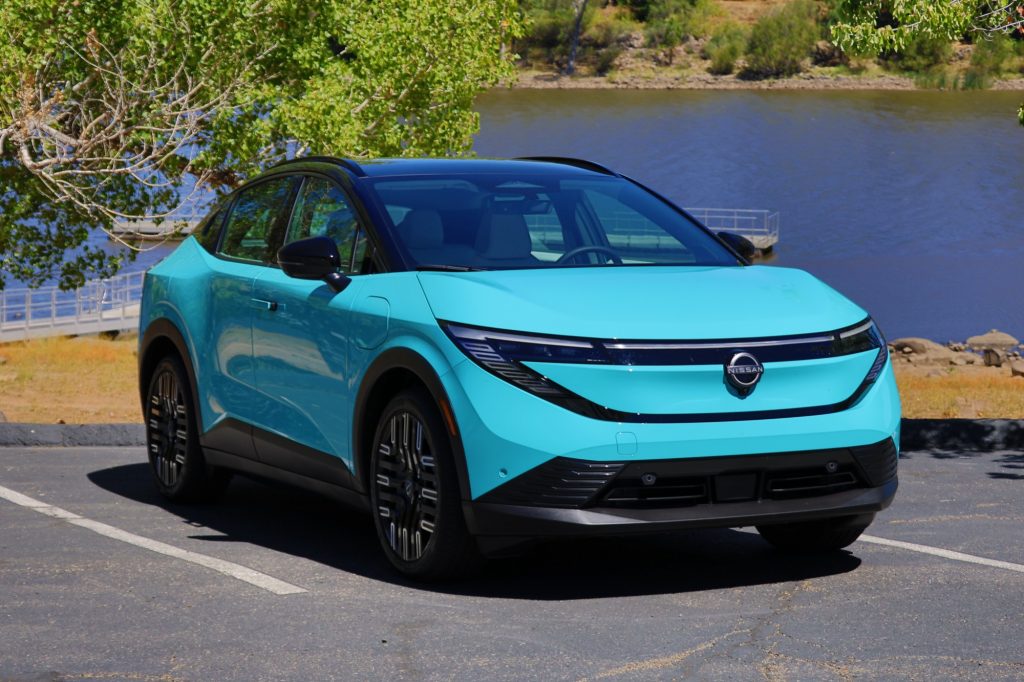
The integrated thermal management ties the HVAC, battery, motor, on-board charger and radiator together to maximize efficiency and get heat where it’s needed. If it’s cold and the driver has the heat on, the system will pull excess heat from the battery, motor and power electronics for the cabin. Standard on the Platinum+ and optional on the SV+ is the ability to heat the battery if it’s too cold to get it into the temperature range needed for maximum charging. This will help avoid the problem of extremely slow or no charging in sub-zero temperatures. According to Nissan, the Leaf will provide similar charging rates from those sub-zero conditions to the 90s and beyond.
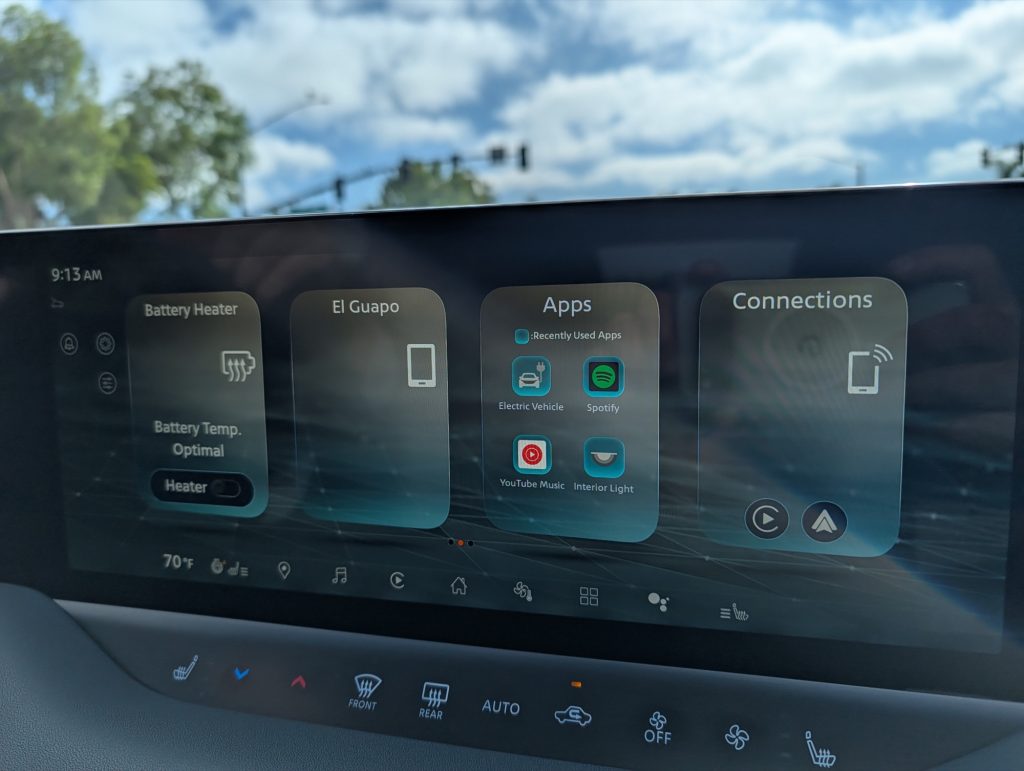
When connected to a DC charger, the Leaf supports peak rates of 150-kW, a big step up from the 50-kW CHAdeMO system and a 10% to 80% charge should take about 35 minutes, roughly half the time of the prior generation despite a larger battery. When equipped with the battery heater, preconditioning of the temperature will occur automatically when a charging station is set as the destination in the navigation. When not using the built-in navigation, the battery heater can be engaged manually in the settings. AC charging is also improved with a standard 7.2-kW on-board charger in place of the 6.6-kW unit used previously. We didn’t get an opportunity to test out any of the charging so that will have to wait for a future test.
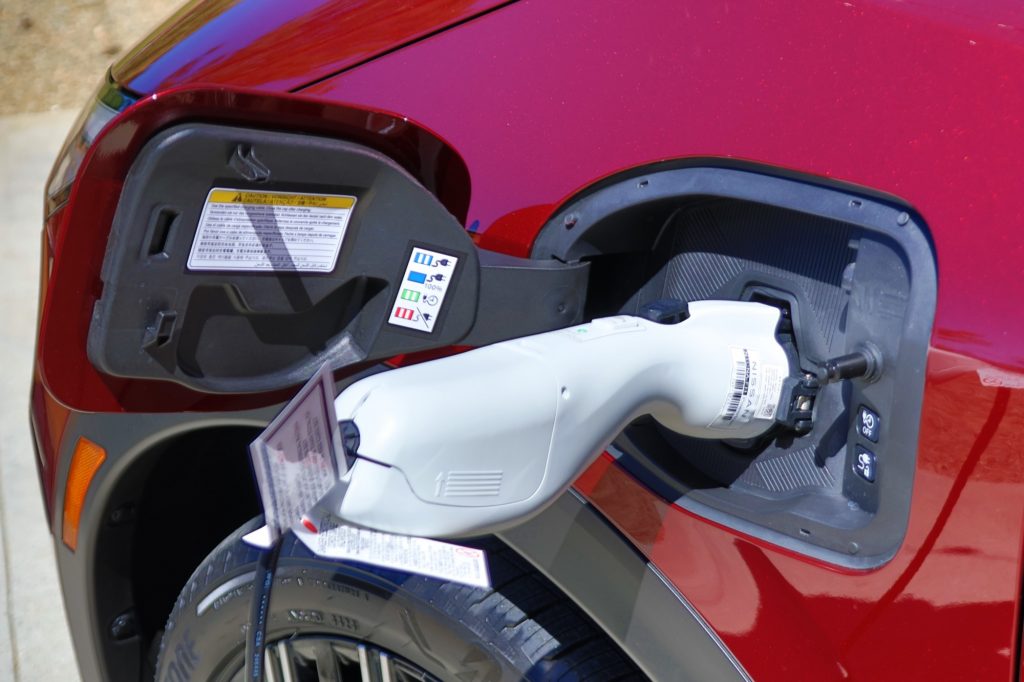
The new Leaf now has the capability to export power through vehicle-to-load. This can be done two different ways. There are two 120V AC outlets in the car, one in the cargo area and another up front by the console. They can put out up to 1.5-kW which can actually power a surprising amount of stuff at a campsite or even if your power goes out at home. Just run an extension cord to the car and you can keep a refrigerator or two running along with some lights and other devices for a couple of days. Another 1.5-kW can be exported through the J1772 charging port using an adapter similar to one offered by Hyundai. Nissan has designed one that will be manufactured by a supplier in the coming months.
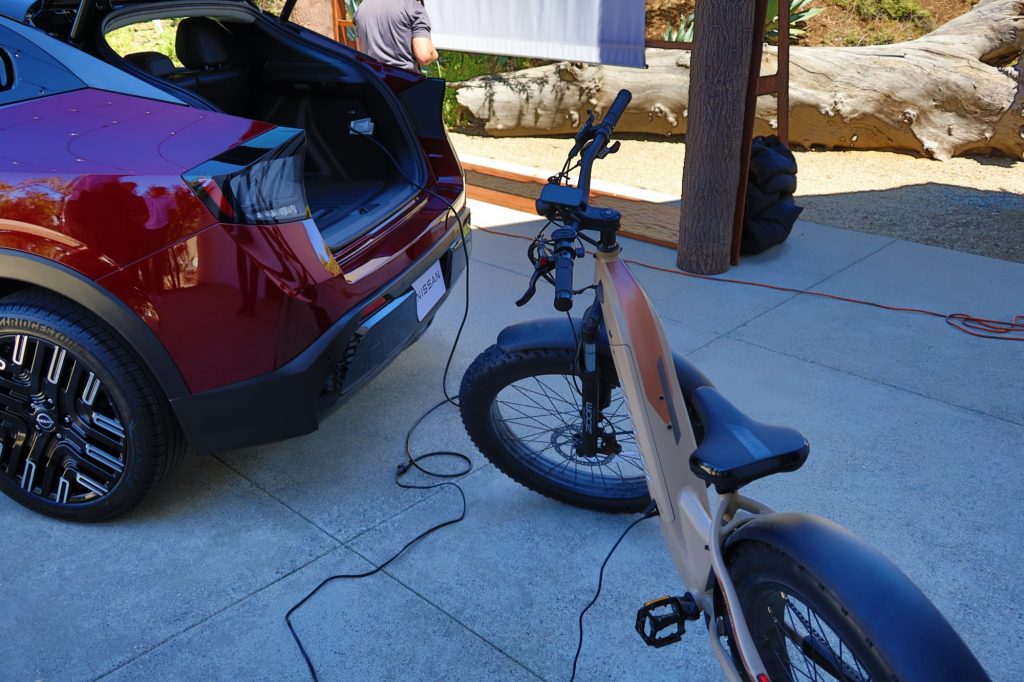
Into The Mountains
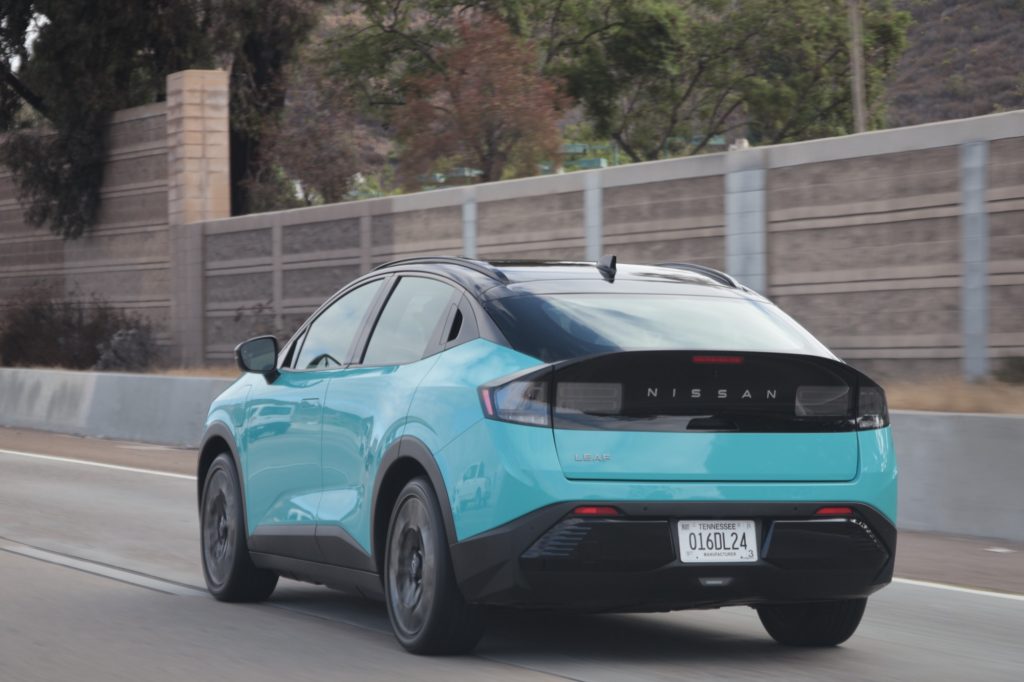
For our first drive, Nissan only brought out a fleet of Platinum+ cars in a choice of Coulis Red Pearl or Seabreeze Blue Pearl, both with a two-tone black roof. That means we had all the options including the 19-inch wheels and tires.
We set out from downtown San Diego and headed north on the freeway before turning east into the mountains for a few hours. At highway speeds, it was immediately clear that the more aerodynamic shape of the Leaf was paying dividends in quietness although our pre-production car did have the slightest hint of wind noise around the passenger door, likely due to a flawed seal. It wasn’t much, but given how quiet everything else was including road noise, it stood out.
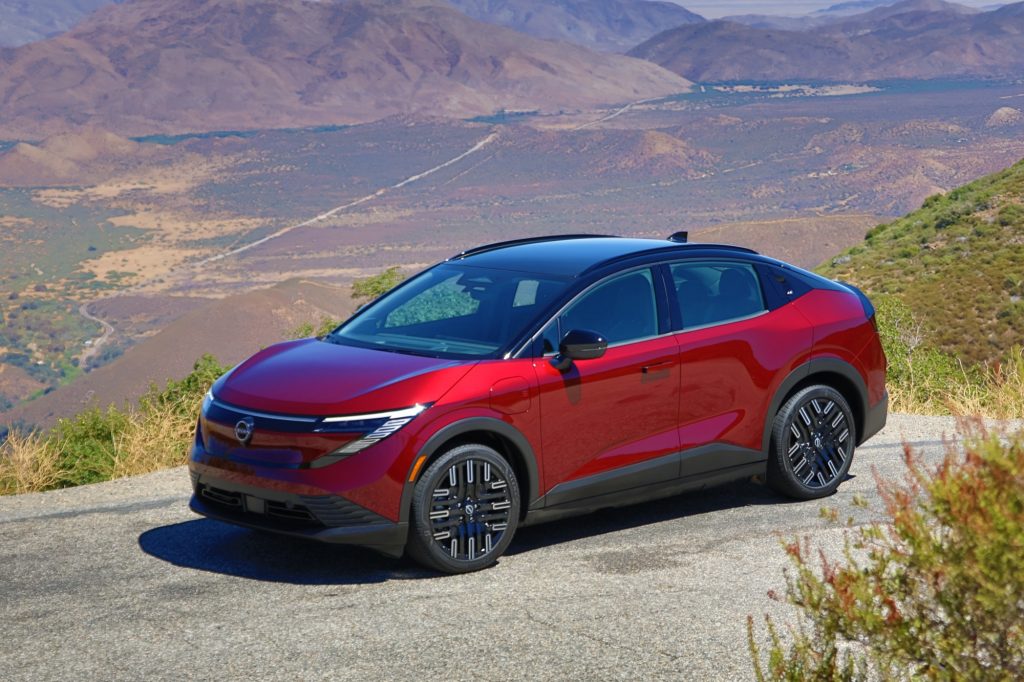
Beyond that, it was very comfortable to ride in. The Leaf does include the ProPilot Assist V1.x which is a hands-free system that was also on the previous generation as well as much of the rest of the current lineup. It combines adaptive cruise control with hands-on lane centering and also includes curve speed adjustment. One thing we did encounter on a couple of occasions was a warning that the system was unavailable and the sensor needed cleaning. Each time it happened when the sun was above and potentially shining into the front camera because it resumed by itself shortly after. I’ve encountered this same issue in the past on the Ariya which uses the V2 system with hands-free capability.
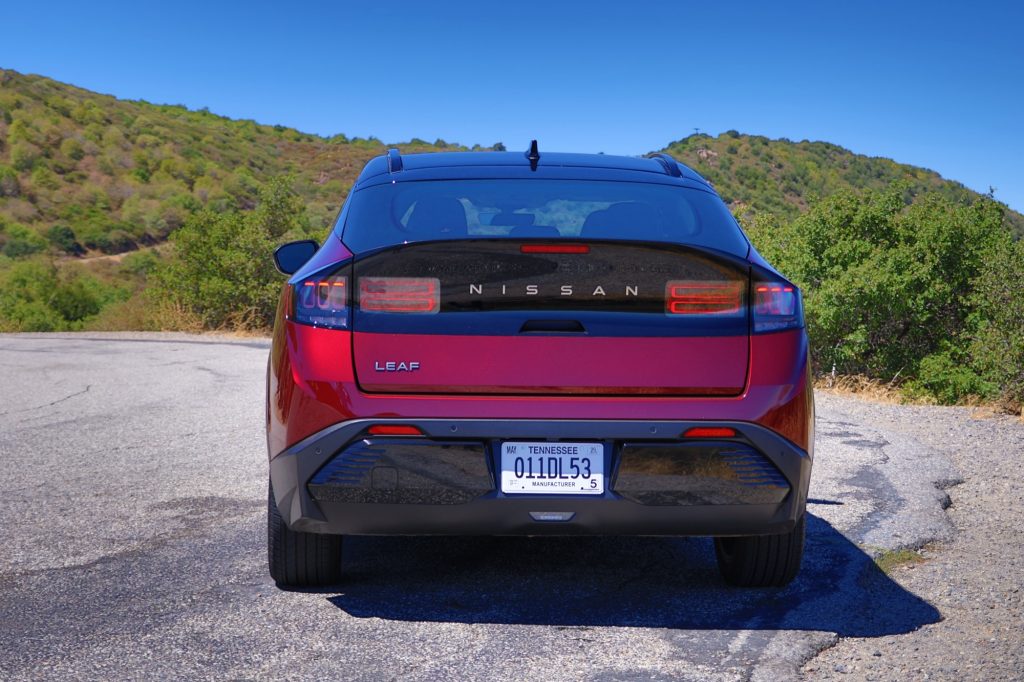
As we got into the mountain roads several things became clear. The new rack-mounted power steering makes a huge difference in feel. The steering is much more direct and precise with no play in the wheel. This might take a bit of getting used to because it can feel almost twitchy at first, but once you’re accustomed to it, it feels much better especially on curving rural roads.
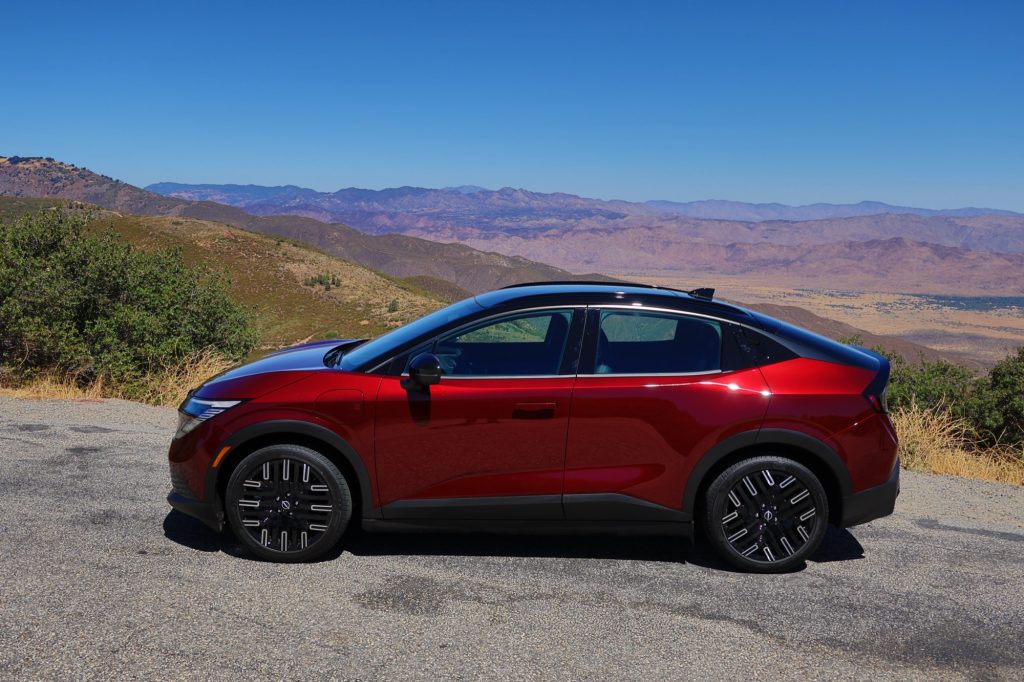
The other characteristic is that the suspension is well controlled and body roll is minimal, especially compared to prior Leafs. However, as the pavement gets a bit more broken, you also tend to feel it a bit more. I wouldn’t go so far as to describe it as harsh overall, because the wheel control is quite good, but there is a bit of impact harshness on cracks and heaves. This can largely be attributed to those 45-series 19-inch tires which don’t offer much sidewall. Hopefully I’ll get a chance to try out the SV+ at some point, especially back in Detroit. The slightly taller sidewall should provide more compliance over those small, sharp impacts and should hold up better against Michigan potholes.
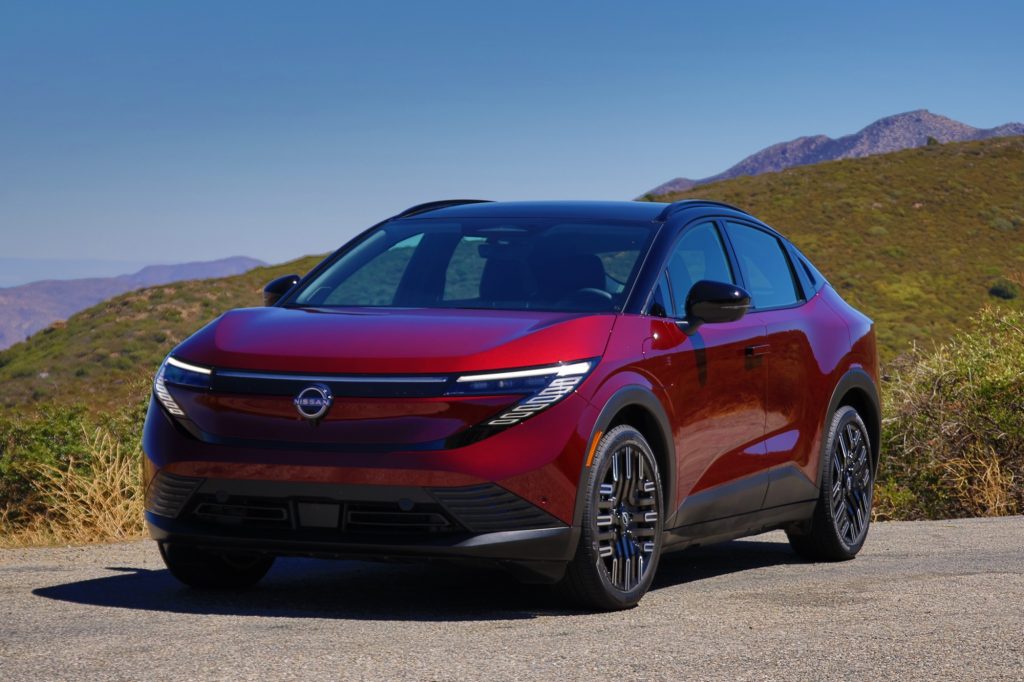
The Leaf isn’t going to be challenging a Model Y Performance for any pink slips at the drag strip, but the instant responsiveness of electric drive always feels good in daily driving. The 214-hp is more than sufficient for merging onto busy freeways and making passing maneuvers on two lane roads. Foot to the floor it will even chirp the front tires on occasion. At the limit in cornering, the Leaf, like most mainstream front wheel drive cars, will understeer, but up to nine-tenths of its capabilities, this is actually a surprisingly fun car to drive on a mountain road.
One-Pedal or Not?

One area that many veteran EV drivers will find disappointing on the new Leaf is the absence of a one-pedal driving mode. Prior Leafs had an e-Pedal button on the console that would enable maximum regenerative braking and the ability to bring the car to a full stop simply by modulating the accelerator pedal. Many EV drivers love this feature once they get used to it and it’s particularly useful in stop and go conditions so you don’t have to keep going back and forth between two pedals. However, every vehicle that offers this also has a more relaxed mode that more closely emulates engine braking in combustion vehicles.
Like the Ariya, the Leaf now has an e-Step button on the dash. Regenerative braking can be managed two ways in the Leaf. Steering wheel paddles can be used to adjust the degree of regen and at its maximum setting, will slow the car down until you get to about 10 mph at which point regen phases out and you have to hit the brake to stop.

Pressing the e-Step button gives just a bit more regen, but it also moves the brake pedal in proportion to how much deceleration there is. When you do go to apply the brake, which you must do to come to a full stop, you will often find the pedal halfway down already which is a bit disconcerting when you are used to it being at a certain height. I and most of the others on the drive really disliked this approach and pressed Nissan to bring back e-Pedal as it was. The hardware can do it, it’s just a matter of a software change. It sounds like the new approach is being pushed from the home office in Japan, but it is still being discussed. In the meantime, I’d suggest not using e-Step and just tapping the paddle to maximize what regen is available.
How Far, How Much?
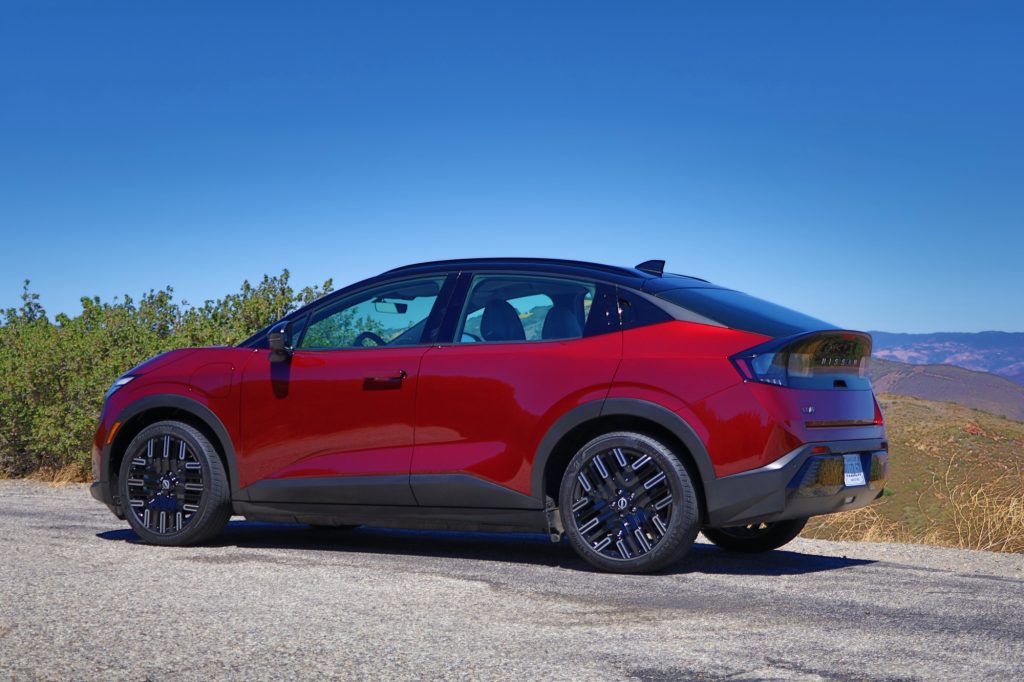
The 2026 Leaf will be in US Nissan dealers in the coming weeks. Through the development process, Nissan made decisions based on the assumption that tax credits wouldn’t generally be an option because the car is no longer being assembled in the US. The new Leaf is exclusively assembled in Japan. That led to some decisions like the absence of dual zone climate control. But overall, this new edition feels far less cheap than the prior model; not premium, but not cheap.
For launch, there will be three trim offerings, S+, SV+ and Platinum+ priced at $31,485, $35,725 and $40,485 including delivery charges. All three come with the 75-kWh battery and have ranges of 303 miles, 288 miles and 259 miles respectively. The reduced range is due to increased weight as features are added and the bigger wheels. The 52-kWh S trim should be about 8-9 months behind, so sometime in spring 2026. Nissan isn’t talking price or range for that version yet, but the only difference between the S and S+ is the battery size, other equipment is identical. I estimate that the 2026 Nissan Leaf S will probably sticker for between $27,000 and $28,000 and offer about 220-230 miles of range.

For now, the Leaf offers a very impressive value proposition especially for someone interested in getting their first EV or even their first new car. At just over $31K delivered, this isn’t far off the price of a comparable gas vehicle and it offers 300 miles of driving range on a charge. As usual, the middle trim is the sweet spot though at less than $36K for almost 290 miles of range and an impressive list of standard features. While the old Leaf was totally competent, but utterly dull, this new generation is actually surprisingly fun to drive and pleasant to look at especially in Seabreeze or red. If only Nissan would relent on one-pedal driving.

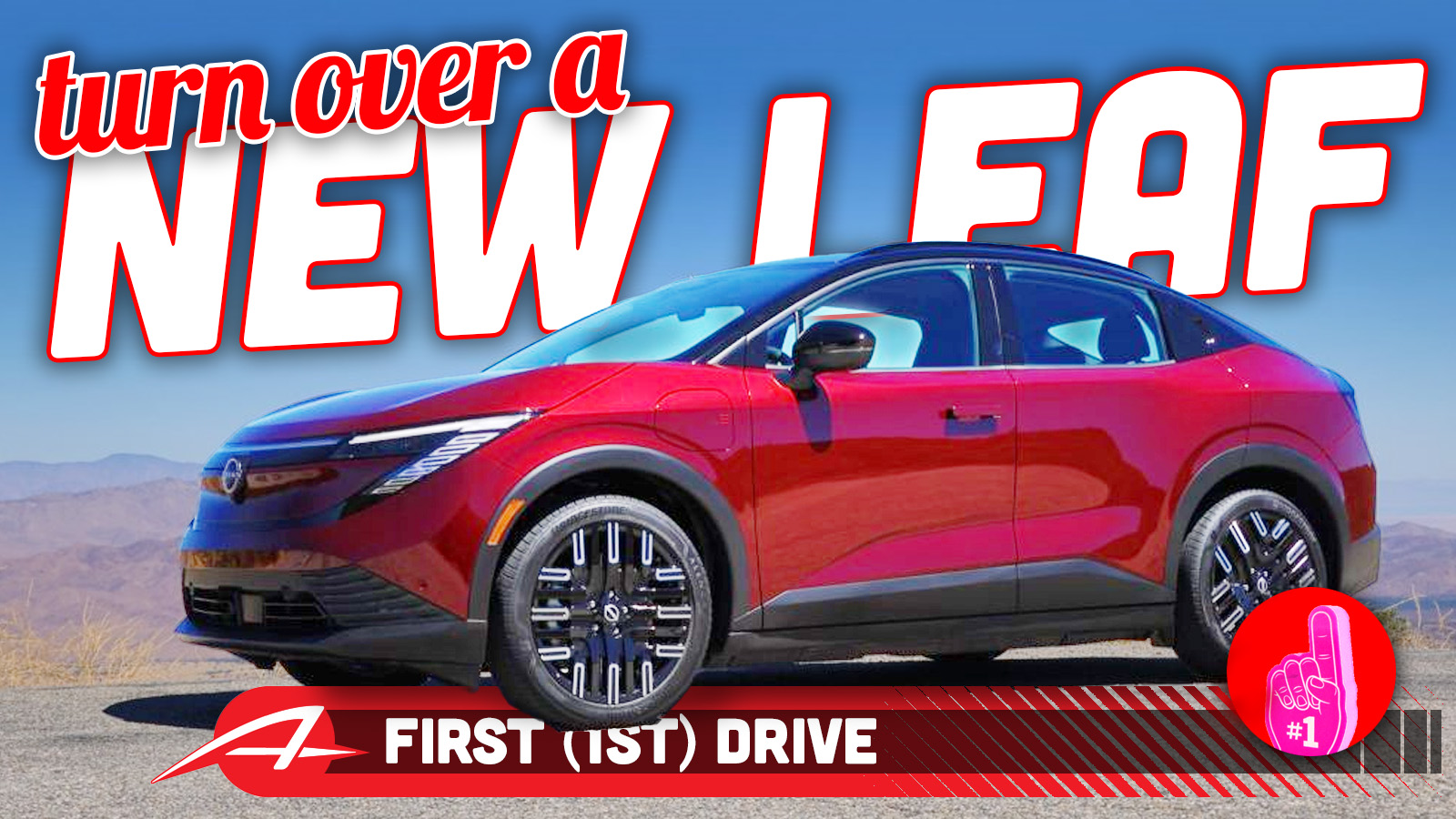







I mean, why even offer it as an option then? If everyone is going to have to just use their phone after a year anyway, they may as well start off using their phone and not bother with the built-in system.
That aside, I really like what this is offering.
I actually don’t think it’s terribly unattractive. The front isn’t great, the side view is ok, and the rear is actually pretty well done.
I just hope you can get one with all the features and without the stupid glass roof. Those things have got to go. Give me something that opens, please! Best way to keep a parked car ventilated.
Nissan’s far from the only one to do this, but it’s kind of obnoxious that the trim level that gets you battery preconditioning also saddles you with the oversized range-killing wheels.
Very nice update overall, though. Impressed that they’re keeping it competitive even as everyone else advances.
Owner of a 2021 Leaf S+ (60kWHr) since new. $23k after rebates for a 225 mile EV. It definitely has room for improvement, but I love that thing. My kids (18 and 20) use it now since it’s just so simple to drive. The new gen 3 looks like it has potential to cure all the real low points of the gen 2. Here’s my take.
Range:
I’m always glad to have more. Very glad I opted for the “Plus”. 225 is plenty but I’d go for the 300 miles on the gen 3. Makes it that much more flexible and also gets you the high power motor.
Battery cooling and NACS port:
Air cooled battery has worked fine for me. I’m in Texas. Battery temp only rises appreciably if you fast charge. Liquid cooling and the NACS charge port on the gen 3 will be great if you hope to road trip it, but little impact otherwise. Fast-charging is too much more expensive than L2 charging to be a daily practice.
Charging:
The gen 2 Leaf is missing a very basic feature. I can’t set a target battery % to charge to. Instead I have to program the charge time. Which means I have to do math and dig through the menu to pick a charge schedule that will get me to the 75% I like to have in the morning. And if I don’t drive the car and leave it plugged in, then it will repeat the charge on the 2nd morning I’ll find it stupidly charged to 100%. So dumb. Make sure the gen 3 can halt charge at a configurable %.
Size:
The gen 2 is so easy to park. People fit in the back seat. Groceries fit in the trunk. Fold-down seats in the rare occasion you haul stuff. Leaf size is best size.
Power:
The gen 2 motor with 215 hp and 250 lb-ft of torque is actually quite powerful. But Nissan programmed the gen 2 software to limit the torque from a stop and at low speeds so you won’t spin the front tires at every green light. It can feel weak at first and then surprisingly responsive once you’re moving (25mph+). For a while I was frustrated at this software as I think the Leaf could have felt a lot more like a hot hatch (comparable to Golf GTI). I’ve made my peace with it now. But pay attention to this during your test drive to see what they’ve done for gen 3.
Steering:
The gen 2 steering is way too light and has zero feel. I’m glad to hear about the improvements they’ve made for response and feel. This was a weak point.
Tires:
The stock Bridgestone Ecopia EP 422 tires that came on the gen 2 are hot garbage. Sacrificed too much traction in the pursuit of range. The compromise worked as expected – good range but they became downright unsafe as they aged and I replaced them early. My replacements are Continental TrueContact Tour 54 in the same size (205/55 R16). Dramatically better traction and ride quality at the cost of about 8% range. Go figure. I don’t know if the Yokohamas and Bridgestones on the gen 3 are garbage or not.
Just a few comments.
It’s interesting how they spell out Nissan instead of using the (updated) Nissan logo on the back deck.
I recently rented a higher-end Nissan Sentra, and it was actually a decent car.
I had a work buddy who bought one of the original gen one of these and LOVED it. He was trying to get all of us to buy one.
The range limitations would have made that unworkable for our weekend plans, but yeah, day-to-day, it would have been ok.
I wish Nissan well, but what I really need is a PHEV. If I ever need to replace what I already have.
The “reality” that ‘x’ company has to market a vehicle as an SUV or crossover to sell it in the US is a false one.
Manufacturers sold really lousy compact cars in the US for a long time — the Fit, the Yaris… heck, the Aveo was so bad they changed the name three times. Does anyone even *remember* the Toyota Echo?
That’s how they were able to insist that “America doesn’t want a compact car” — because what they very cleverly (in the pejorative sense) *weren’t* saying was, “…when the only options are each a snowshovelful of crap, and Americans only get to choose whether they want cat, dog, cow, or hog crap”.
The reason “nobody can sell” compact cars, hot hatches, sedans, and coupes in America is that nobody’s *offering* them. The market is *there*, but we can’t all be Mercedes Streeter and import two JDM auction listings a year!
Ultimately what it comes down to, predictably, is money. SUVs and crossovers and pickup trucks are more profitable. So, we only get those kinds of vehicles to choose from unless we want to do the overly expensive naked run through brambles and nettle with hot coals under our feet that is international importing.
If you want proof that American car companies are scared as heck of foreign imports, look at how complex the import process actually is, and how hard imported vehicle registration is, the fact that the Chicken Tax has never been repealed, and — to touch briefly on another article here on The Autopian — that nifty little trick Dodge and the others are pulling with CARB. They aren’t trying to “work things out”, they’re burning time, which puts pressure on the CARB states to walk back all of that stuff so that people my age (and, probably more commonly, the generation after me, I’m a Millennial but only by the skin of my teeth) will then “be able” to buy cars that are only 44-state legal because Dodge refuses to put CARB-compliant engine choices in them… because a dirty engine is a cheap engine, comparatively. Never mind that I’d still like to be able to walk outside and breate air without a gas mask, once I’m as old as my parents are now…
It’s called social engineering. You tell someone that they can’t have the car they want because it’s only available in your statevwith ‘x’, ‘y’, and ‘z’ engines. Never mind that ‘a’, ‘b’ and ‘c’ engines could fit in just fine and be 50-state, they aren’t available on *that* car. You’ve got to buy a different car for that… and the only way to fix it is to buy both and swap em yourself — if you want to void your warranty! So, you only get *those* cars in other states, because *your* state insisted on voting in CARB. *They’re* the reason! (Not the stonewalling car company, gee whiz, why’d you ever think that?) So, you go off, call your local legislators, tell them CARB’s in the way of you getting a new car. *They* then go in front of the State Legislature and say, well I’ve got all these people in my district upset about CARB, it’s preventing them from buying better cars! So a whole bunch of em vote down CARB and get it all walked back. The car company suddenly doesn’t have to make nice with CARB and can sell cheaper, crappie engines… and pockets the difference. Profit.
It’s all about the money.
Neither the Fit nor Yaris (Scion iA originally) were or are “lousy” cars
I’ve heard a veritable tidal wave of comments about the Yaris that pretty uniformly disagree with you, and what I’d describe as ‘mixed opinions’ on the Fit.
Glad you seem to have had good experiences in both, though!
300 miles $35k ENOUGH horsepower first time i’m actually seriously interested in an electric car. The looks are a bit frumpy but maybe it will look better in black or silver or some other color. If my employer was not DOUBLING my health insurgence costs next year i would probably consider getting one!
“Last year, it tried to merge with Honda, but the deal fell apart when Honda saw it more as a takeover than a merger.”
I’ll take your word for it as you are the journalist. But from what I gathered it was the opposite.
While the brand is a punching bag in the US, it is one of Japan’s biggest legacy automakers. For example, a fledgling Toyota once looked to Nissan/Datsun factories as a model of build quality. Nissan (along with Prince) also developed Japan’s first legit race car, the R380.
Seems like no Japanese exec wanted to go down in history as being the guy responsible for handing a historic company over lock, stock and barrel to a younger, more successful competitor. Honda, feeling/knowing it held all the cards, overlooked this and bruised some egos.
While, I don’t use this much in my day-to-day life these days, I do have the history degree and lots of historiography experience. I’m always interested in viewpoints that are contrary to the establishment, and this is definitely one of those. Japan is definitely waaaaay outside my area of expertise, but I would truly appreciate any sources that you could point to that informed this comment.
Commenting culture always makes things hard, but I certainly hope that you will take this as genuine curiosity, and not a pretext to start an argument.
It’s pure enthusiast speculation based on Japan’s collectivist cultural leanings and Nissan’s significance as a company there. If there’s anything a Japanese man hates, it’s losing face (see WWII).
Imagine being the guy who helped run Ford into the ground so badly that it had to be handed over to GM in a glorified takeover.
You’d be going into the negotiation looking for a reason to walk away.
I will definitely be considering one of these next time I need a car. Which I hope is not soon.
I like this a lot! The styling isn’t 100% my thing but it’s different in a good way. The dual charging points is an excellent feature as well. But can we stop using fabric on top of dashboards and door panels? I detailed cars as a side job for years and can tell you that those fabric topped surfaces will get gross fast. Otherwise I hope it does well, Nissan could use a win and it seems to be a competitive offering.
It’s well known that larger tires will hurt the range, but I’ve never heard of added feature weight having this much effect on EV range. Typically weight is not a big factor in EV range because the energy used to accelerate the weight is mostly recaptured during deceleration.
Awaiting the wagon version. Longer roof, vertical hatch.